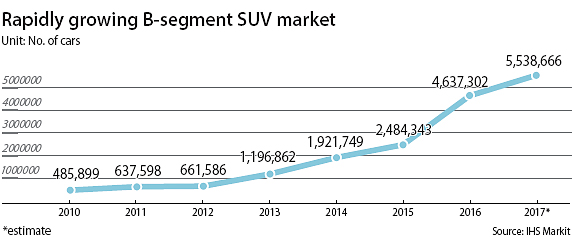At Hyundai Motor, a focus on breadth in sport utility options

The Korean automaker plans to expand its SUV lineup to all five segments from A to E in the next three years, Chung Eui-sun, vice chairman of Hyundai Motor, said during a launch event for the subcompact Kona SUV on Tuesday.
Hyundai Motor currently has four SUV models under its roof: the Creta (known in China as the ix25), a B-segment car; the Tucson, a C-segment car; the Santa Fe, a D-segment car; and the Maxcruz, another D-segment car.
“With the full SUV lineup, we are trying to give wider options to consumers,” Chung said.
This means by 2020, Hyundai will likely have a mini SUV that falls in the A segment, which is smaller than the Kona, and a large SUV for the E segment that is bigger than the Santa Fe.
The company also plans to expand the powertrain from existing diesel and gasoline engines to all-electric and fuel cell. The electric version of the Kona will launch in the first half of next year, according to Jung Rak, the company’s vice president. Hyundai Motor is also planning to mass-produce an SUV that runs on a fuel-cell powertrain in time with the PyeongChang Winter Olympics in Korea next year.
“We are focusing on battery and fuel-cell research instead of hybrid or plug-in hybrid because we think that is eventually where the eco-friendly car market will head,” Chung said.
Until now, Hyundai Motor has been staying away from the small SUV market. The automaker’s strong suits have long been sedans and midsize SUVs. But with the B-segment SUV market showing constant growth, Hyundai Motor is belatedly jumping into the market.
According to IHS Markit, the B-segment SUV market is one of the fastest-growing segments, recording an average 45.6 percent annual growth for the past six years. There were some 4.6 million cars sold in 2016, nearly 10 times that in 2010 mark, when only 485,000 were sold. It is expected to grow to 5.5 million cars this year.
On the late jump, Chung remarked, “We take safety as a top priority when developing a car. It’s not virtual connection. It may take longer than other carmakers, but we are going to always put safety at the forefront.”
BY JIN EUN-SOO [jin.eunsoo@joongang.co.kr]










with the Korea JoongAng Daily
To write comments, please log in to one of the accounts.
Standards Board Policy (0/250자)